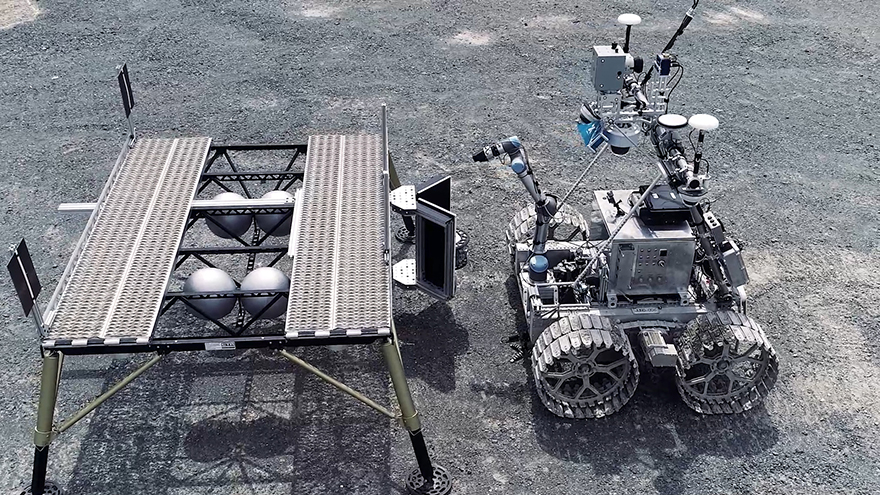Lunar Exploration Analogue Deployment (LEAD)
Simulating missions here on Earth, with realistic conditions and constraints, is a very effective way to refine technology, test science protocols and learn how all the systems required to explore new worlds can come together to work effectively in space.
Between and , the Canadian Space Agency () partnered with the European Space Agency (ESA) to conduct a series of field tests to replicate scenarios of a sample-return mission from the Moon. The field tests were known as the Lunar Exploration Analogue Deployment (LEAD), and their objective was to gain knowledge and hands-on experience to prepare the science and technology required for the next chapter of space exploration: sending humans to more distant destinations like the Moon and Mars.
LEAD consisted of a series of engineering and science tests conducted on the CSA's Juno rover. These tests were performed in three phases, one per year, in a rock quarry in Quebec.
Video showing Juno in action during the LEAD field tests. (Credit: CSA)
Objectives
1. Perform a simulated sample-return mission
Juno successfully collected three samples (of rocks and soil) and returned them to a mock lunar lander, all via remote control. During LEAD, the CSA tested a new feature on its Juno rover: the Lunar Sample Handling System, which can be attached to Juno's robotic arm to enable the rover to scoop, rake or grip rocks. The rover was able to use the system to collect target samples on command, store them and deliver the filled sample container to a lunar lander nearby. In an actual Moon sample-return mission, an ascent vehicle would subsequently lift off from the lander to bring the samples back to Earth, where scientists would be able to study them in detail.
2. Gather realistic travel information during remote operations
In order to plan real lunar missions, strategic planners and rover pilots need to know how differences in the terrain will impact the rover's speed and distance covered. Since rovers on the surface of other worlds will have to operate with lags in communications, mission teams also need to be able to identify the degree of autonomy best suited to the surface they need to explore. During LEAD, the CSA successfully tested Juno's Guidance, Navigation & Control software and demonstrated that onboard autonomy is beneficial in real-time operations.

The dotted line in yellow represents the path that Juno chose to take around the boulders on the left when its onboard Guidance, Navigation & Control software was tested. (Credit: CSA)

The Guidance, Navigation & Control software allows the rover to detect and locate objects in real time. (Credit: CSA)
3. Assess user interface and rover tools
Rovers carry an assortment of science instruments, sensors and other equipment to carry out their missions. Getting all this gear to work together is the task of a master remote control station. For LEAD, Juno was operated remotely using the CSA's Apogy software, which allows multiple operators and tools to carry out procedures simultaneously.
The LEAD field tests replicated the difficulty of managing commands from multiple remote control centres, with the rover being operated by teams based in Longueuil (Quebec, Canada) and in Germany. Operators also had to work with limited bandwidth and take into account a delay between their commands and the action carried out by the rover. This is exactly like a real lunar mission, where there is a lag in communications (of several seconds) due to the distance between the Moon and Earth.

A team of operators at the Canadian Space Agency in Longueuil, Quebec, commanding Juno during the LEAD field tests. (Credit: CSA)
360° video of the LEAD field tests. (Credit: CSA)
The LEAD team also used the rover's lidar scanner and onboard lights and cameras to test its ability to function in low-light conditions in order to emulate operations in regions of the Moon where the Sun never shines.

The Juno rover collecting a soil sample during a night operation. (Credit: CSA)
The LEAD team
- Canadian Space Agency
- At the operations centre in Longueuil, Quebec
- Remotely operated and performed a series of tests on the Juno rover, and shadowed the ESA control team in Germany. Monitored operations and gathered data to establish a comparison of metrics on methods tested by both teams.
- On site at the quarry
- Established and maintained communication links with the other teams, troubleshot, and ensured the safe operations of the rover.
- At the operations centre in Longueuil, Quebec
- European Space Agency
- European Space Operations Centre (ESOC) (Germany)
- Remotely operated and performed a series of tests on the Juno rover, and shadowed the CSA team in Longueuil.
- European Space Research and Technology Centre (ESTEC) (Netherlands)
- Supported the CSA in establishing requirements to conduct the field tests.
- European Space Operations Centre (ESOC) (Germany)
Explore further
- Date modified:



